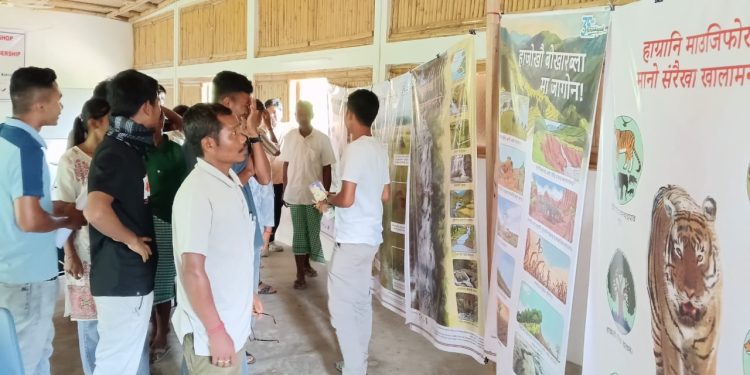Premier biodiversity conservation organisation Aaranyak (www.aaranyak.org) organised a consultation with representatives from Bhuyanpara, Bamunkhal, Majrabari, Kora ibari, Thwribari, Randhanipara, and Gorumara located on the fringes to Manas National Park, to finalise the strategy related to village-level awareness and education programme, natural resource management (NRM) plan development as well as assess the scope and interest of the community leadership to set up experimentally predator-proof coral in the project village. The programme, organised at the Manas Conservation and Outreach Centre of Aaranyak, was attended by 16 members from 6 out of 10 project villages and the 10 volunteers from the designated project villages.
Aaranyak’s senior official Jayanta Kumar Sarma shared the key objectives of the consultation at the outset. During the first technical session, the participants shared that stress related to the scarcity of water is one of the major challenges related to the natural resources in the project villages. The water crisis has aggravated due to the gradual drying up of most of the traditional Dongs in the area due to severance of the sources inside Manas National Park (MNP).
They also suggested that conflict with wildlife species is a serious challenge regarding raising crops especially during the winter, as these species in conflict keep damaging their crops regularly.
Basanta Das and Mangal Medhi from Bhuyanpara stated, “We were part of a human-wildlife conflict mitigation experiment initiated and supported by Aaranyak. As part of this, three different varieties of fences – solar, green net and sound-making wire fence – were set up, and we cultivated coriander, red lentil, potato and peas during the winter months. We harvested a produce that was many times more than the amount harvested in the past without using fences. We are happy that we could take part in this process, and we want to continue with the practice.”
Participants from Bamunkhal showed interest in taking part in this experiment process during the next winter season. Representative from Thwribari stated that the major challenge for the people in the village is lack of agriculture land. He suggested that the villagers keep livestock at their homes and that the lifting of livestock by the wild animals, mainly leopards and tigers are a regular phenomenon.
Jayanta Kumar Sarma asked the participants whether they would be interested in participating in an experiment on the protection of livestock, in a similar way as to the crop protection experiment taken up during the winter. The participants agreed unequivocally.
They suggested that they would propose the names of the participants for the programme by the end of May 2025, and the process of setting up the protection tools will be finished by August 2025 after training the artisans on constructing predator-proof corrals.
The villagers were also briefed on the status of human-wildlife interaction across the project villages through a short presentation by Dr Partha Sarathi Ghose. During the second session, the discussions focused on upcoming series of awareness and education programmes in the landscape. Jayanta Samra requested the participants to suggest a tentative period during which these programmes can be conducted in the villages.
The villagers suggested it would be ideal if the programmes were taken up before June 15, 2025, since they would be busy with the paddy cultivation activities thereafter. It was decided that the villagers would conduct discussions at the village level with concerned members of the village committee and provide the dates to hold the Natural Resource Management Programme in the respective project villages.
It was also agreed that the programmes will be organised in partnership with the Gami Afad in the respective villages. During the concluding session, the discussions revolved around the proposed Village Plan development to be initiated in the villages. Participants were briefed that the village plan development will be preceded by the resource mapping of individual villages with support from the community members.
The process of village mapping was explained to them through a short presentation by Dr Ghose. It was emphasised that the mapping process and plan would help the communities work out plan for future management of natural resources.
The programme concluded with gifting participants with saplings of cinnamomum tamala as a token of appreciation from Aaranyak. The programme was coordinated by Jayanta Kumar Sarma with support from Swapan Kumar Das, Bijay Basumatary, Barnali Baro, Shaikhong Basumatary, Dr Partha Sarathi Ghose and the entire team of the Manas Conservation and Outreach Centre.
Aaranyak is committed towards conservation of rich biodiversity and natural heritages of NE India by supporting our indigenous people and local communities for Alternative and Sustainable Livelihoods and other nature-based solutions. The programme was organised with financial support from IUCN-KfW.





